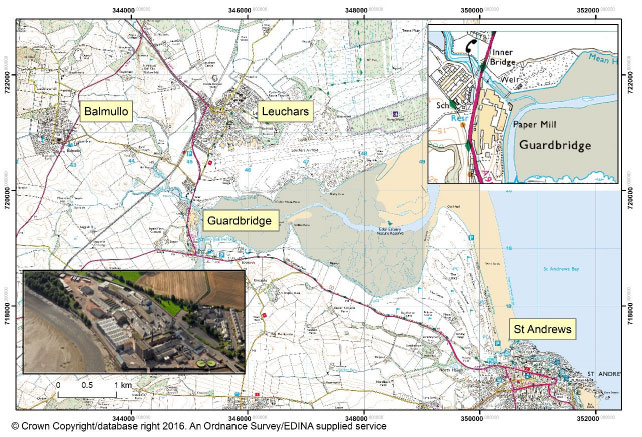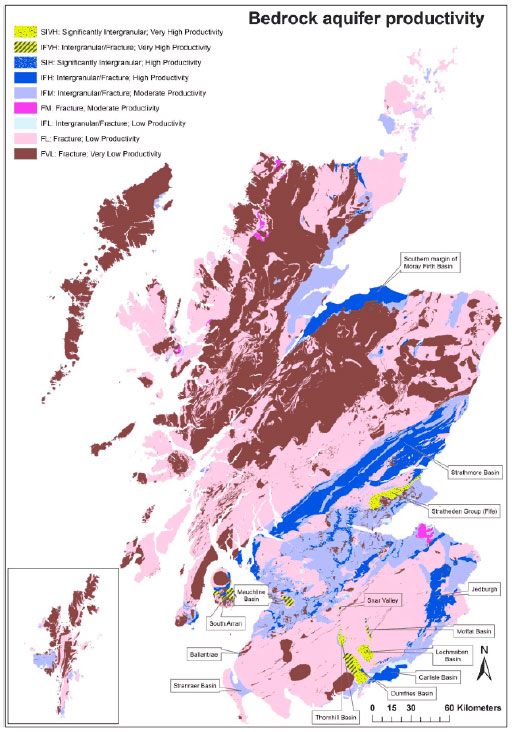Guardbridge geothermal technology demonstrator project: feasibility report
Report of the study exploring the potential of a geothermal district heating system accessing hot sedimentary aquifer resources underlying Guardbridge, Fife.
1. Introduction
1.1 Project Scope
This feasibility study investigates whether a geothermal district heating system, which accesses Hot Sedimentary Aquifer ( HSA) resources underlying a brownfield site at Guardbridge in northeast Fife (Fig. 1.1), can be developed in a cost-effective manner. The Guardbridge site is located in some of the highest productivity aquifers in Scotland (Fig. 1.2), based on recent groundwater productivity assessments and the AECOM report into deep geothermal energy potential in Scotland (Gillepie et al., 2013). This project's scope is to assess the available geological information and estimate the Hot Sedimentary Aquifer ( HSA) heat supply, calculate the current heat demand at the Guardbridge site, Guardbridge village, and the nearby towns of Leuchars and Balmullo, and incorporate future Guardbridge development plans (provided by the University of St Andrews) and anticipated growth in housing stock (from Fife Council) to estimate future heat demand. The capital, maintenance and repair costs for the geothermal well and designed district heating network are used to develop economic models for a number of district heat network scenarios. A key aspect of this study is an evaluation of the opportunities to cost effectively de-risk deep geothermal exploration in Central Scotland, and to outline the potential for developing geological heat storage systems. The study identifies the key legislative and environmental issues, risks and uncertainties associated with any exploration and production, involves stakeholder engagement, and makes recommendations for a Phase 2 stage for geothermal heat development at Guardbridge.
Fig. 1.1: Location of Guardbridge site in relation to surrounding communities. Inset map (top right) shows Guardbridge site in more detail. View in aerial photo (bottom left) is towards the southwest.

The old Guardbridge paper mill is owned by the University of St Andrews and is currently being transformed into a major low-carbon energy innovation centre. An investment of £25m was awarded to install a 6.5MW biomass heating centre at Guardbridge, and develop a district heating scheme for a subset of the University buildings in St Andrews; this will be operational during 2016. The new remit for Guardbridge as a low-carbon energy innovation centre, which will support research and development into energy integration, end- or off-grid supplies and circular economies, provides a very suitable location for exploring the potential for a geothermal heating scheme to serve the buildings and businesses within the Guardbridge site, and district heating networks for the communities in close proximity to the site.
Fig. 1.2: Bedrock productivity map based on rock characteristics and type of groundwater flow. The map does not account for variability in productivity with depth (from Ó'Dochartaigh et al., 2011).

1.2 Objectives
The key challenges and outstanding questions limiting the commercial development of geothermal heat energy in Scotland are:
- establishing the economic feasibility of geothermal exploration for heat;
- the lack of adequate datasets that reduce the risks associated with expensive drilling projects,
- the need for more sophisticated optimisation techniques accommodating well design, heat pump usage, and exploration depth,
- the lack of sub-surface geological and fluid flow models which provide frameworks for identifying and developing reservoirs that can sustain long term fluid and heat flow, and
- the development of diverse energy storage systems, and integration of geothermal storage into existing energy production and storage methods.
To test the old assumptions that geothermal resources are not economic, two of the key outputs from this feasibility study will be the economic model and business case based on different heat demand options, and an optimised model of well design based on different exploration strategies. Both are transferable to similar operations at other geothermal sites. The key objectives are therefore to:
- design a geothermal well that will be drilled in Phase 2 of the project, and secure valuable information on the Fife regional sub-surface geology and geothermal properties of the primary aquifer,
- explore how advanced drilling techniques, such as directional drilling, can be deployed to improve geothermal recovery,
- demonstrate how a geothermal system can integrate with an existing biomass heating installation to optimise both schemes and provide a district heat network for on-site industries and the local community,
- evaluate the potential for storage of seasonal heat energy in the subsurface (a first in Scotland), and
- assess the relative merits of water treatment and on-site recycling, re-injection or disposal to sea.
Contact
There is a problem
Thanks for your feedback